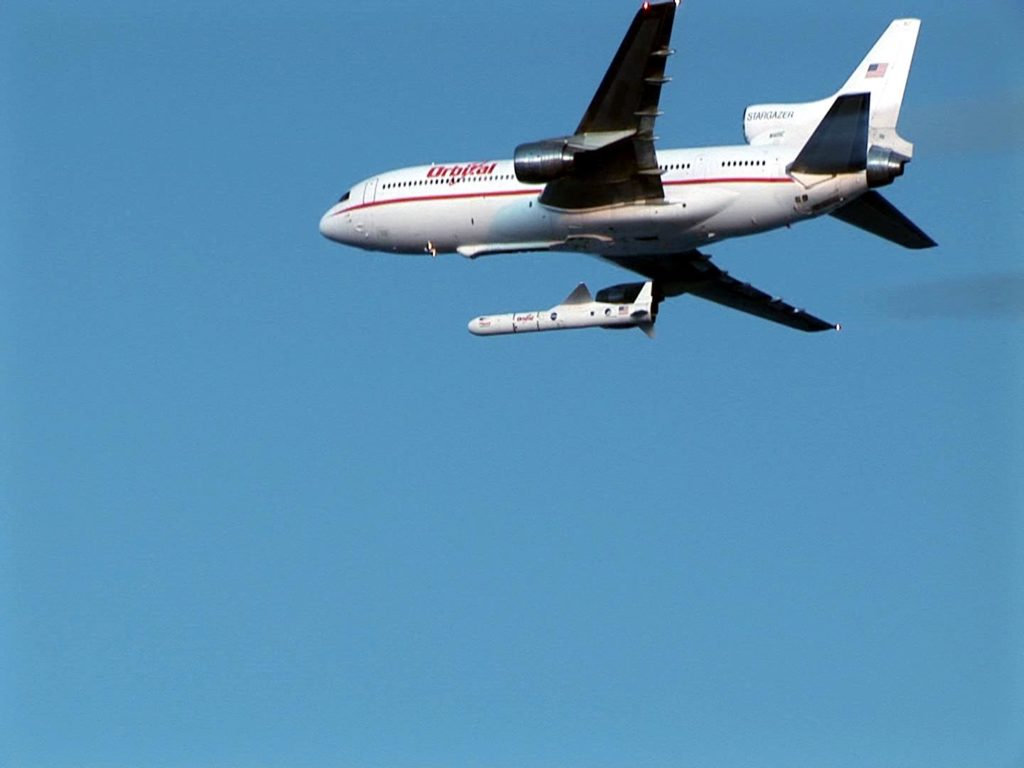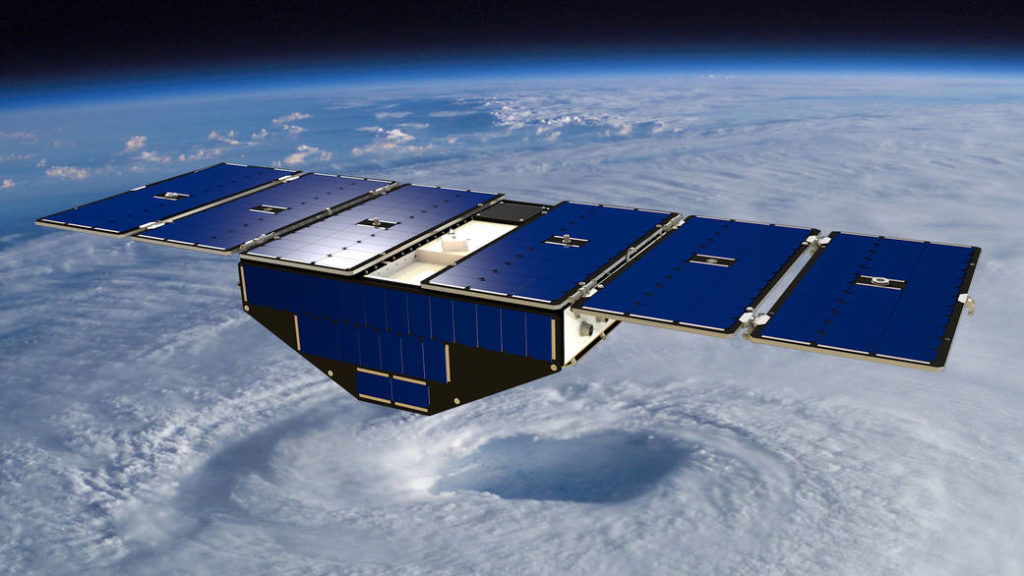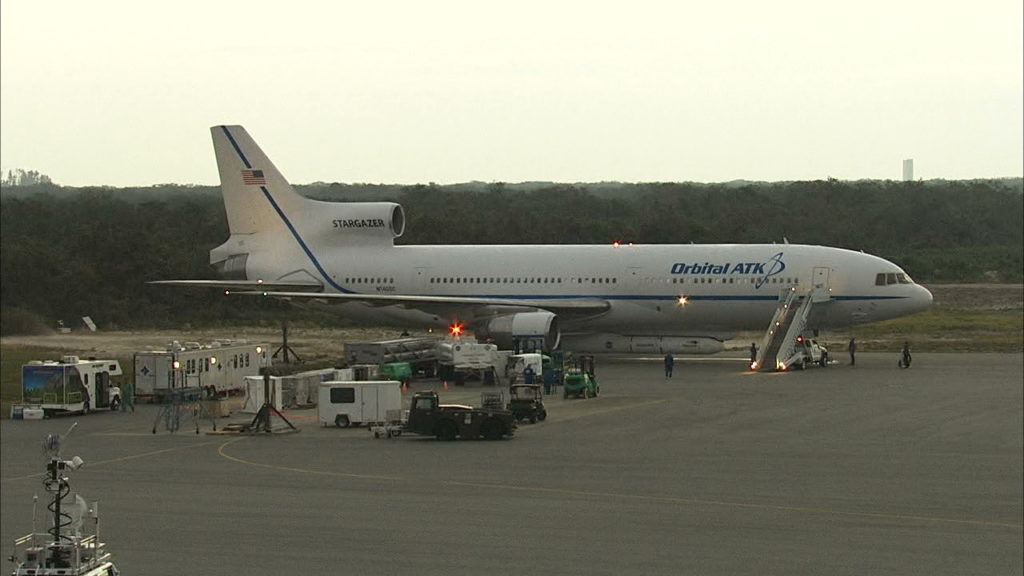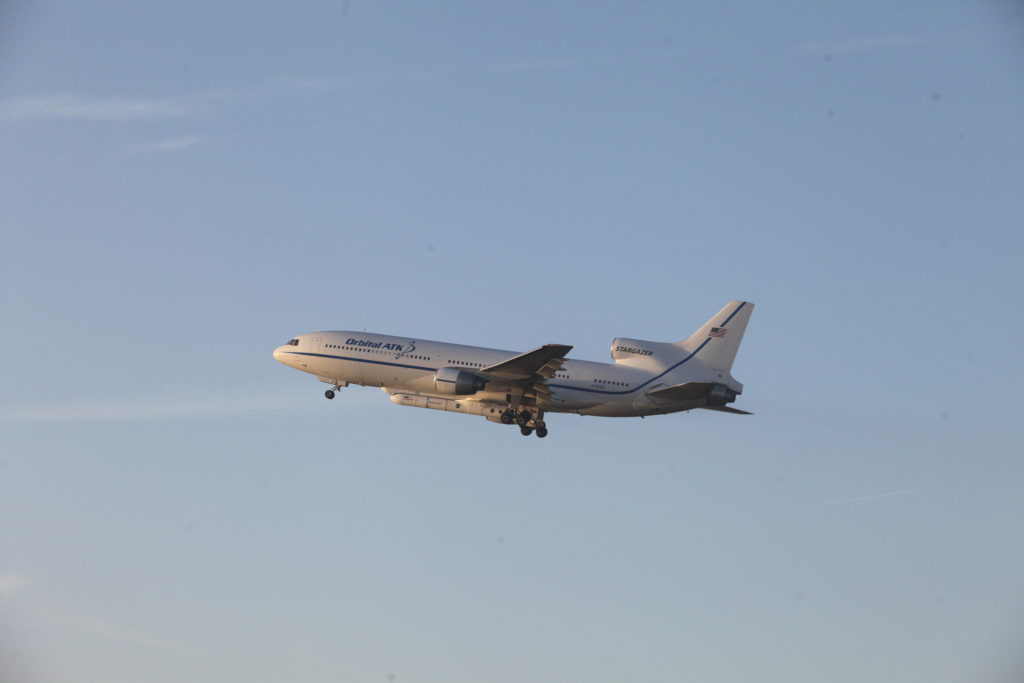
The Orbital ATK Stargazer L-1011 aircraft is taxiing to the end of the runway at the Skid Strip in preparation for takeoff.
The F-18 chase plane should follow shortly.

The three-stage, all-solid-fueled Orbital ATK Pegasus XL rocket is the only airborne, commercially developed launch vehicle. At 55 feet long, if stood on its end it would be about half the height of the Statue of Liberty. Its 39,000-foot deployment altitude is 10,000 feet higher than Mount Everest, the highest point on Earth – and the aircraft that carries it to that altitude is Orbital ATK’s L-1011 aircraft, “Stargazer.”
NASA’s Launch Services Program, or LSP, is based at the agency’s Kennedy Space Center in Florida. The program selects the best launcher for each mission’s payload, and selected the Pegasus XL vehicle for the eight microsatellites comprising the CYGNSS spacecraft.
CYGNSS will be the 15th NASA mission LSP has launched aboard the Pegasus vehicle.

CYGNSS will utilize a constellation of eight microsatellite observatories that will be placed in a circular orbit more than 316 miles above the Earth’s surface. With an orbital inclination of 35 degrees, the small spacecraft will concentrate on the region nearest the equator — the tropics — where these cyclones form. The mission will measure surface winds in and near a hurricane’s inner core, including regions beneath the eyewall and intense inner rainbands that previously could not be measured from space.
Once fully deployed, each of the 61-pound CYGNSS microsatellites will measure about 5.4 feet long by 1.7 feet wide, and a depth of about three quarters of a foot. The Delayed Doppler Mapping Instrument (DDMI) installed on each satellite will provide wind-field imagery of the formation, intensification and decay of tropical cyclones in unprecedented detail. The DDMI also allows the CYGNSS observatories to receive signals from GPS satellites as well as signals reflected off the ocean’s surface.
The CYGNSS mission is planned to last at least two years, the minimum design life of the microsatellites.

NASA’s Cyclone Global Navigation Satellite System mission, or CYGNSS, is scheduled to begin this morning with launch aboard an Orbital ATK Pegasus XL rocket at 8:35 a.m. EST. The one-hour launch window extends until 9:21 a.m. Forecasters with the U.S. Air Force 45th Weather Squadron predict a 90 percent chance of favorable conditions at launch time, so weather is not expected to be a concern today.
Preflight activities are in progress at the Skid Strip runway at Cape Canaveral Air Force Station in Florida, where Orbital’s “Stargazer” L-1011 aircraft will take off with the rocket, carrying it to an altitude of about 39,000 feet and deploying it about 110 nautical miles east-southeast of Daytona Beach. The access door to the forward section of the plane is closed, the stairs have been removed and all three engines are running.
The CYGNSS mission features a set of eight microsatellites that will fly in formation more than 300 miles above Earth, measuring ocean surface winds throughout the life cycle of tropical cyclones and helping scientists and forecasters better understand how these storms intensify.
Takeoff of the L-1011 is expected around 7:35 a.m. A NASA F-18 aircraft provided by the agency’s Armstrong Flight Research Center in California will serve as a chase plane today, providing visual contact and video of the L-1011, Pegasus XL rocket and the drop/launch sequence. The F-18 will take off shortly before the L-1011.
Today’s launch of NASA’s CYGNSS spacecraft aboard an Orbital ATK Pegasus XL rocket now is scheduled for 8:35 a.m. EST. The launch window extends to 9:21 a.m. The weather outlook has improved to a 90 percent chance of favorable conditions at launch time, with cumulus clouds the primary concern. Weather currently is “green” on all Eastern Range and user constraints.
Live updates from the countdown begin here on the blog and on NASA TV at 7 a.m.
The Pegasus XL rocket is an air-launched vehicle that begins its flight after it is dropped from Orbital ATK’s modified L-1011 aircraft, “Stargazer,” which will take off from the Skid Strip runway at Cape Canaveral Air Force Station and carry the rocket to its release point above the Atlantic Ocean an altitude of approximately 39,000 feet.
So, for those visiting or living in the Central Florida area who are looking for viewing suggestions, this will be a tough launch to see outside, and viewing online and on television is recommended.
The CYGNSS launch planned for Wednesday, Dec. 14 is being delayed due to an issue with flight parameter data used by spacecraft software. The issue was discovered during routine testing Tuesday. The new flight parameter data have undergone verification testing on the engineering model, and will be uploaded to the spacecraft on Wednesday. The uploading of new flight data is a very routine procedure, and is expected correct the issue. The next launch attempt will be determined pending the results of ongoing tests.

Meteorologists with the U.S. Air Force 45th Weather Squadron are predicting a 90 percent chance of favorable weather for the launch of NASA’s Cyclone Global Navigation Satellite System (CYGNSS) mission, scheduled for Wednesday at 8:25 a.m. EST. The one-hour launch window opens at 8:20 a.m.
The CYGNSS spacecraft will ride into orbit aboard an Orbital ATK air-launched Pegasus XL rocket. Orbital ATK’s modified L-1011 aircraft, “Stargazer,” will deploy the Pegasus XL and its CYGNSS payload from an altitude of approximately 39,000 feet above the Atlantic Ocean.
During the two-year mission, the eight CYGNSS microsatellites will fly in formation about 316 miles above Earth’s surface, focusing on the tropics and studying wind speeds and intensification of tropical cyclones such as hurricanes.
Live updates from the countdown will begin at 7 a.m. here on the blog and on NASA Television.
NASA Launch Manager Tim Dunn of the Launch Services Program recapped today’s launch attempt. The hydraulic system problem developed en route, after takeoff, in the last 25 minutes prior to the initial 8:30 a.m. launch time. The hydraulic system in question was not for the L-1011 aircraft itself, but for the system that allows the Pegasus XL rocket to release from the aircraft. That system was not meeting its prescribed pressures, indicating a problem with the hydraulic pump.
“The team did a lot of valiant troubleshooting in the air,” Dunn said. “Everyone wanted to have another launch attempt today, so we continued right up until the L-4 minute point.”
Weather also posed problems at times during the countdown, Dunn pointed out.
“The pilots flew around, under and over a lot of precipitation and bad clouds,” he said.
Should the team resolve the hydraulic pump issue in time for a Tuesday morning launch attempt, the launch window is the same as today’s, and weather is improved, with an 80 percent “go” forecast.
The L-1011 is headed back to the Skid Strip runway at Cape Canaveral Air Force Station in Florida with an expected arrival time of 9:27 a.m. EST.